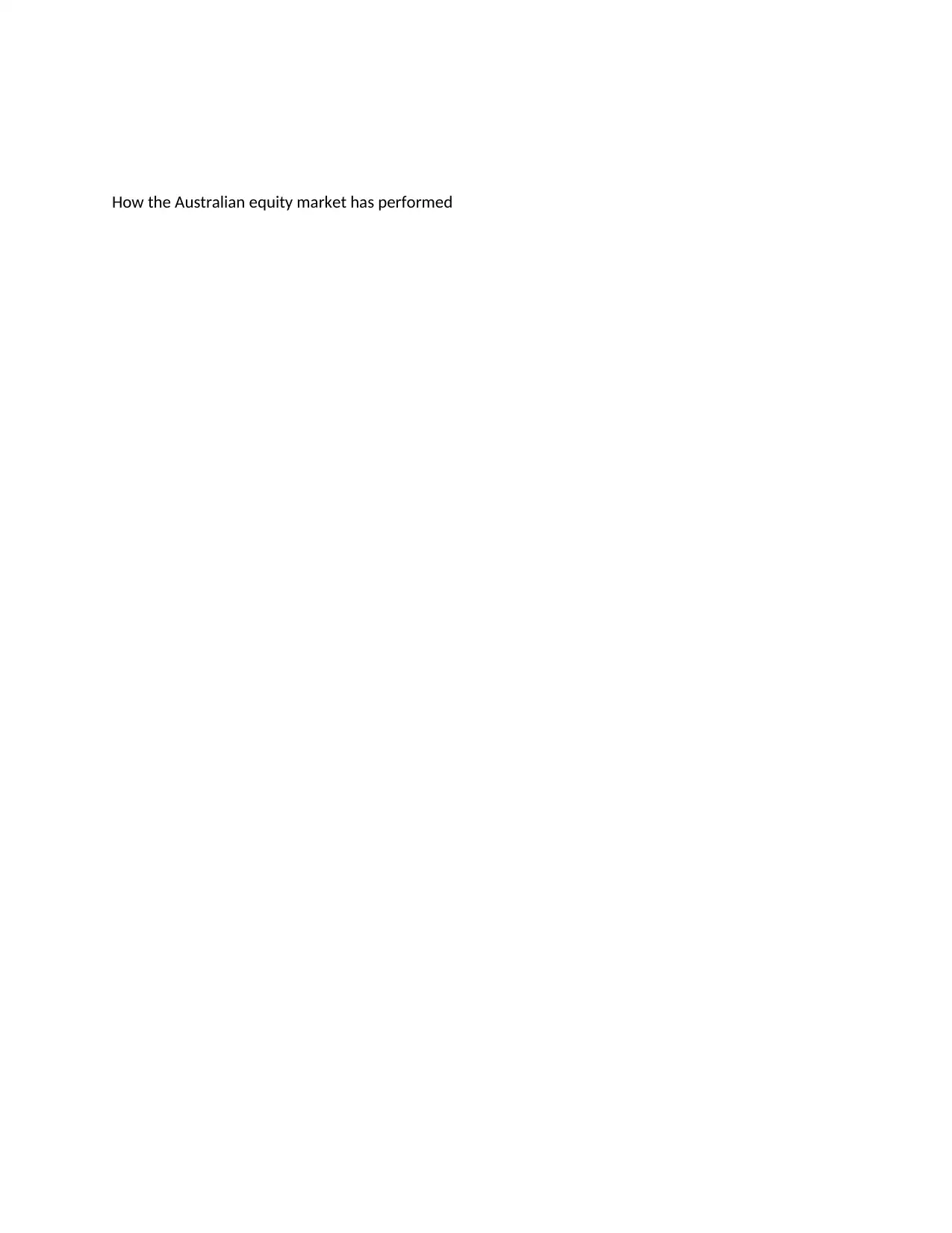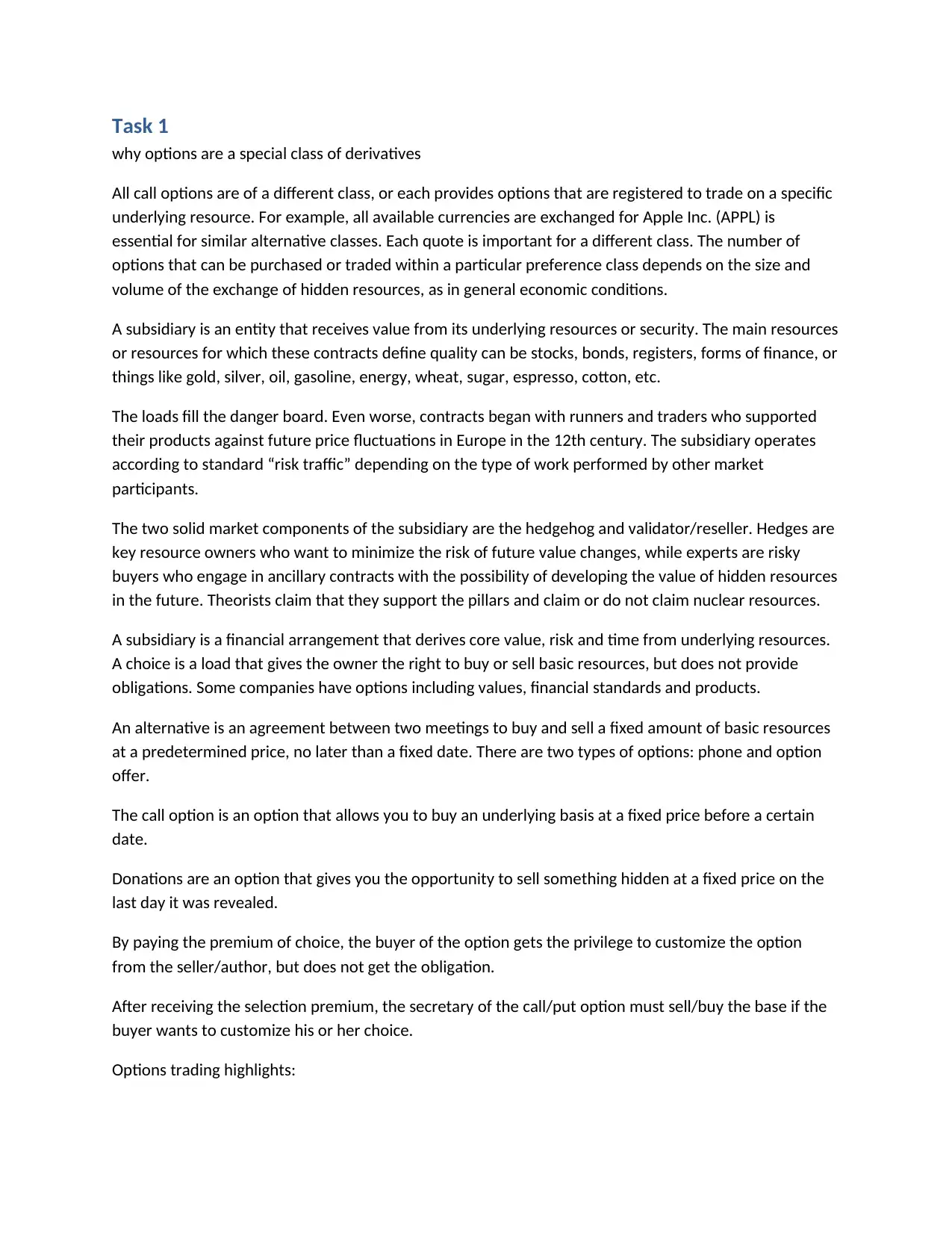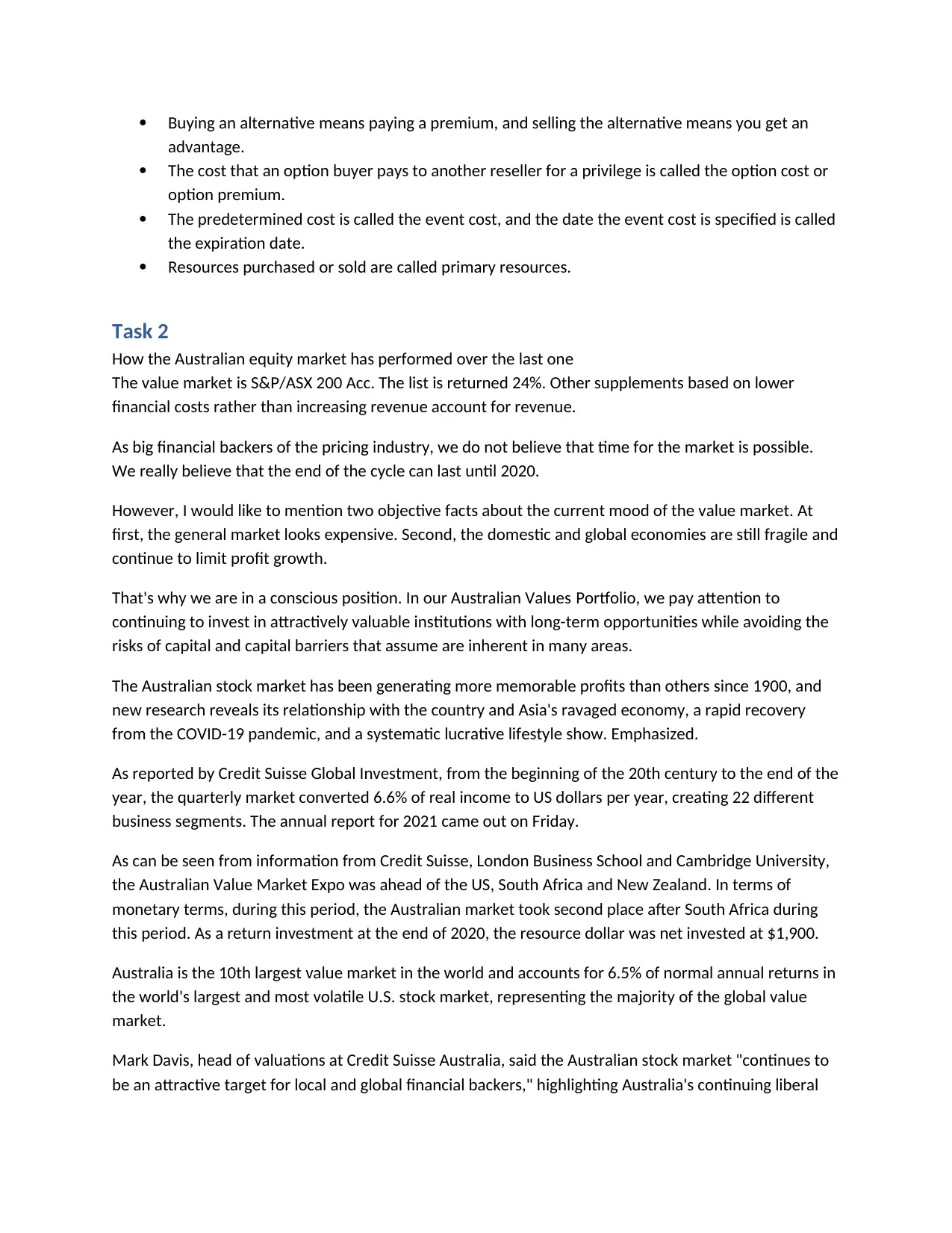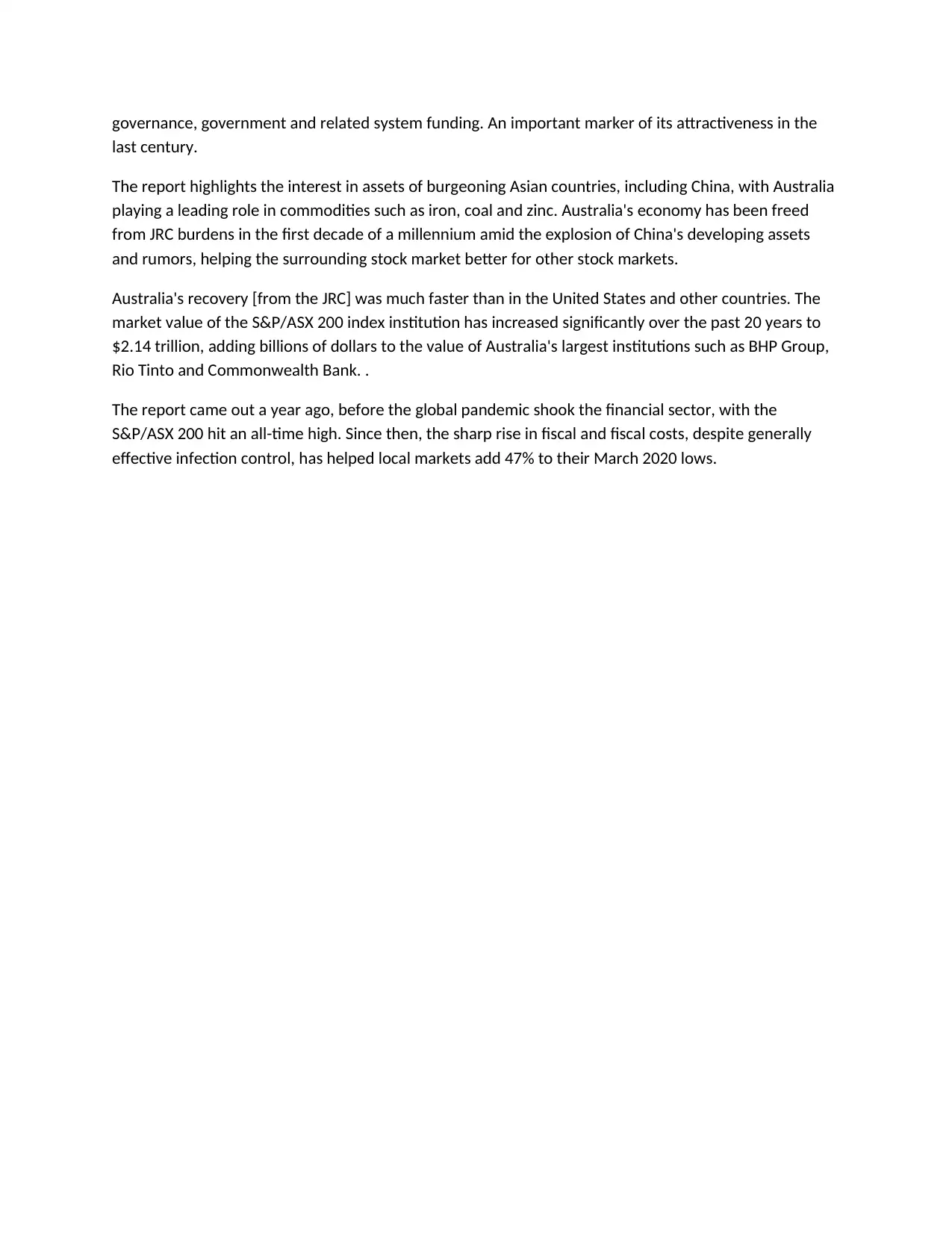Interactive Brokers Group: Options, Equity Market Performance Analysis
VerifiedAdded on 2022/11/30
|4
|1210
|224
Case Study
AI Summary
This case study presents a financial analysis of options and the Australian equity market, tailored for clients of Interactive Brokers Group (IBG). Task 1 explains options as a special class of derivatives, differentiating between call and put options and their functionalities. Task 2 delves into the Australian equity market's performance over the past year, examining key indicators such as the S&P/ASX 200 Acc. The analysis includes insights into market trends, economic factors influencing performance, and the market's attractiveness for both local and global investors, highlighting its historical performance and future outlook based on expert opinions. The study also discusses Australia's economic recovery and its impact on the stock market, presenting a comprehensive view for informed investment decisions.

How the Australian equity market has performed
Paraphrase This Document
Need a fresh take? Get an instant paraphrase of this document with our AI Paraphraser

Task 1
why options are a special class of derivatives
All call options are of a different class, or each provides options that are registered to trade on a specific
underlying resource. For example, all available currencies are exchanged for Apple Inc. (APPL) is
essential for similar alternative classes. Each quote is important for a different class. The number of
options that can be purchased or traded within a particular preference class depends on the size and
volume of the exchange of hidden resources, as in general economic conditions.
A subsidiary is an entity that receives value from its underlying resources or security. The main resources
or resources for which these contracts define quality can be stocks, bonds, registers, forms of finance, or
things like gold, silver, oil, gasoline, energy, wheat, sugar, espresso, cotton, etc.
The loads fill the danger board. Even worse, contracts began with runners and traders who supported
their products against future price fluctuations in Europe in the 12th century. The subsidiary operates
according to standard “risk traffic” depending on the type of work performed by other market
participants.
The two solid market components of the subsidiary are the hedgehog and validator/reseller. Hedges are
key resource owners who want to minimize the risk of future value changes, while experts are risky
buyers who engage in ancillary contracts with the possibility of developing the value of hidden resources
in the future. Theorists claim that they support the pillars and claim or do not claim nuclear resources.
A subsidiary is a financial arrangement that derives core value, risk and time from underlying resources.
A choice is a load that gives the owner the right to buy or sell basic resources, but does not provide
obligations. Some companies have options including values, financial standards and products.
An alternative is an agreement between two meetings to buy and sell a fixed amount of basic resources
at a predetermined price, no later than a fixed date. There are two types of options: phone and option
offer.
The call option is an option that allows you to buy an underlying basis at a fixed price before a certain
date.
Donations are an option that gives you the opportunity to sell something hidden at a fixed price on the
last day it was revealed.
By paying the premium of choice, the buyer of the option gets the privilege to customize the option
from the seller/author, but does not get the obligation.
After receiving the selection premium, the secretary of the call/put option must sell/buy the base if the
buyer wants to customize his or her choice.
Options trading highlights:
why options are a special class of derivatives
All call options are of a different class, or each provides options that are registered to trade on a specific
underlying resource. For example, all available currencies are exchanged for Apple Inc. (APPL) is
essential for similar alternative classes. Each quote is important for a different class. The number of
options that can be purchased or traded within a particular preference class depends on the size and
volume of the exchange of hidden resources, as in general economic conditions.
A subsidiary is an entity that receives value from its underlying resources or security. The main resources
or resources for which these contracts define quality can be stocks, bonds, registers, forms of finance, or
things like gold, silver, oil, gasoline, energy, wheat, sugar, espresso, cotton, etc.
The loads fill the danger board. Even worse, contracts began with runners and traders who supported
their products against future price fluctuations in Europe in the 12th century. The subsidiary operates
according to standard “risk traffic” depending on the type of work performed by other market
participants.
The two solid market components of the subsidiary are the hedgehog and validator/reseller. Hedges are
key resource owners who want to minimize the risk of future value changes, while experts are risky
buyers who engage in ancillary contracts with the possibility of developing the value of hidden resources
in the future. Theorists claim that they support the pillars and claim or do not claim nuclear resources.
A subsidiary is a financial arrangement that derives core value, risk and time from underlying resources.
A choice is a load that gives the owner the right to buy or sell basic resources, but does not provide
obligations. Some companies have options including values, financial standards and products.
An alternative is an agreement between two meetings to buy and sell a fixed amount of basic resources
at a predetermined price, no later than a fixed date. There are two types of options: phone and option
offer.
The call option is an option that allows you to buy an underlying basis at a fixed price before a certain
date.
Donations are an option that gives you the opportunity to sell something hidden at a fixed price on the
last day it was revealed.
By paying the premium of choice, the buyer of the option gets the privilege to customize the option
from the seller/author, but does not get the obligation.
After receiving the selection premium, the secretary of the call/put option must sell/buy the base if the
buyer wants to customize his or her choice.
Options trading highlights:

Buying an alternative means paying a premium, and selling the alternative means you get an
advantage.
The cost that an option buyer pays to another reseller for a privilege is called the option cost or
option premium.
The predetermined cost is called the event cost, and the date the event cost is specified is called
the expiration date.
Resources purchased or sold are called primary resources.
Task 2
How the Australian equity market has performed over the last one
The value market is S&P/ASX 200 Acc. The list is returned 24%. Other supplements based on lower
financial costs rather than increasing revenue account for revenue.
As big financial backers of the pricing industry, we do not believe that time for the market is possible.
We really believe that the end of the cycle can last until 2020.
However, I would like to mention two objective facts about the current mood of the value market. At
first, the general market looks expensive. Second, the domestic and global economies are still fragile and
continue to limit profit growth.
That's why we are in a conscious position. In our Australian Values Portfolio, we pay attention to
continuing to invest in attractively valuable institutions with long-term opportunities while avoiding the
risks of capital and capital barriers that assume are inherent in many areas.
The Australian stock market has been generating more memorable profits than others since 1900, and
new research reveals its relationship with the country and Asia's ravaged economy, a rapid recovery
from the COVID-19 pandemic, and a systematic lucrative lifestyle show. Emphasized.
As reported by Credit Suisse Global Investment, from the beginning of the 20th century to the end of the
year, the quarterly market converted 6.6% of real income to US dollars per year, creating 22 different
business segments. The annual report for 2021 came out on Friday.
As can be seen from information from Credit Suisse, London Business School and Cambridge University,
the Australian Value Market Expo was ahead of the US, South Africa and New Zealand. In terms of
monetary terms, during this period, the Australian market took second place after South Africa during
this period. As a return investment at the end of 2020, the resource dollar was net invested at $1,900.
Australia is the 10th largest value market in the world and accounts for 6.5% of normal annual returns in
the world's largest and most volatile U.S. stock market, representing the majority of the global value
market.
Mark Davis, head of valuations at Credit Suisse Australia, said the Australian stock market "continues to
be an attractive target for local and global financial backers," highlighting Australia's continuing liberal
advantage.
The cost that an option buyer pays to another reseller for a privilege is called the option cost or
option premium.
The predetermined cost is called the event cost, and the date the event cost is specified is called
the expiration date.
Resources purchased or sold are called primary resources.
Task 2
How the Australian equity market has performed over the last one
The value market is S&P/ASX 200 Acc. The list is returned 24%. Other supplements based on lower
financial costs rather than increasing revenue account for revenue.
As big financial backers of the pricing industry, we do not believe that time for the market is possible.
We really believe that the end of the cycle can last until 2020.
However, I would like to mention two objective facts about the current mood of the value market. At
first, the general market looks expensive. Second, the domestic and global economies are still fragile and
continue to limit profit growth.
That's why we are in a conscious position. In our Australian Values Portfolio, we pay attention to
continuing to invest in attractively valuable institutions with long-term opportunities while avoiding the
risks of capital and capital barriers that assume are inherent in many areas.
The Australian stock market has been generating more memorable profits than others since 1900, and
new research reveals its relationship with the country and Asia's ravaged economy, a rapid recovery
from the COVID-19 pandemic, and a systematic lucrative lifestyle show. Emphasized.
As reported by Credit Suisse Global Investment, from the beginning of the 20th century to the end of the
year, the quarterly market converted 6.6% of real income to US dollars per year, creating 22 different
business segments. The annual report for 2021 came out on Friday.
As can be seen from information from Credit Suisse, London Business School and Cambridge University,
the Australian Value Market Expo was ahead of the US, South Africa and New Zealand. In terms of
monetary terms, during this period, the Australian market took second place after South Africa during
this period. As a return investment at the end of 2020, the resource dollar was net invested at $1,900.
Australia is the 10th largest value market in the world and accounts for 6.5% of normal annual returns in
the world's largest and most volatile U.S. stock market, representing the majority of the global value
market.
Mark Davis, head of valuations at Credit Suisse Australia, said the Australian stock market "continues to
be an attractive target for local and global financial backers," highlighting Australia's continuing liberal
⊘ This is a preview!⊘
Do you want full access?
Subscribe today to unlock all pages.

Trusted by 1+ million students worldwide

governance, government and related system funding. An important marker of its attractiveness in the
last century.
The report highlights the interest in assets of burgeoning Asian countries, including China, with Australia
playing a leading role in commodities such as iron, coal and zinc. Australia's economy has been freed
from JRC burdens in the first decade of a millennium amid the explosion of China's developing assets
and rumors, helping the surrounding stock market better for other stock markets.
Australia's recovery [from the JRC] was much faster than in the United States and other countries. The
market value of the S&P/ASX 200 index institution has increased significantly over the past 20 years to
$2.14 trillion, adding billions of dollars to the value of Australia's largest institutions such as BHP Group,
Rio Tinto and Commonwealth Bank. .
The report came out a year ago, before the global pandemic shook the financial sector, with the
S&P/ASX 200 hit an all-time high. Since then, the sharp rise in fiscal and fiscal costs, despite generally
effective infection control, has helped local markets add 47% to their March 2020 lows.
last century.
The report highlights the interest in assets of burgeoning Asian countries, including China, with Australia
playing a leading role in commodities such as iron, coal and zinc. Australia's economy has been freed
from JRC burdens in the first decade of a millennium amid the explosion of China's developing assets
and rumors, helping the surrounding stock market better for other stock markets.
Australia's recovery [from the JRC] was much faster than in the United States and other countries. The
market value of the S&P/ASX 200 index institution has increased significantly over the past 20 years to
$2.14 trillion, adding billions of dollars to the value of Australia's largest institutions such as BHP Group,
Rio Tinto and Commonwealth Bank. .
The report came out a year ago, before the global pandemic shook the financial sector, with the
S&P/ASX 200 hit an all-time high. Since then, the sharp rise in fiscal and fiscal costs, despite generally
effective infection control, has helped local markets add 47% to their March 2020 lows.
1 out of 4
Related Documents
Your All-in-One AI-Powered Toolkit for Academic Success.
+13062052269
info@desklib.com
Available 24*7 on WhatsApp / Email
![[object Object]](/_next/static/media/star-bottom.7253800d.svg)
Unlock your academic potential
Copyright © 2020–2025 A2Z Services. All Rights Reserved. Developed and managed by ZUCOL.



